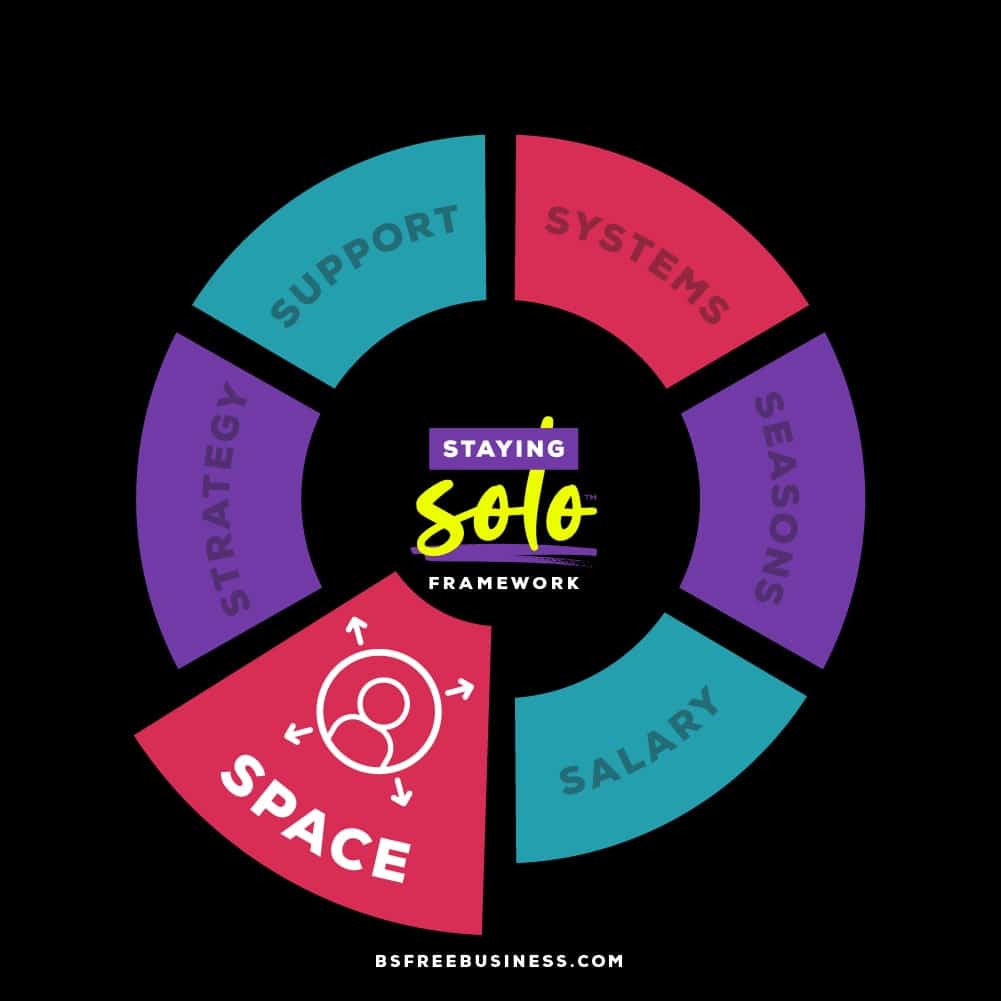
Carving Out
Consistent Space
By Maggie Patterson
All opinions in this post are my opinions and mine alone.
Service business owners often think that the “service” part of the business model means they have to run themselves ragged serving their clients. Or that they need to work around the clock to reach their goals. Nothing could be further from the truth.
In this episode, we’re digging into the need for “space” as a solopreneur, what that really means, and why it matters more than most of us realize.
Listen Now To This Essay On The BS-Free Service Business Show
The Risky Reality of Entrepreneurship
A 2015 study by Freeman et al examined the prevalence of mental health issues amongst entrepreneurs, with 72% of participants self-reporting mental health issues including depression and substance abuse.
More recently, the 2021 FLIK Mental Health of Female Founders Report found that women and non-binary people in the study reported a lack of work/life balance and a “lifestyle of burnout and anxiety”. 52% of respondents reported dealing with mental health issues including depression (36.6%) and anxiety (33.3%).
It’s worth noting that there is a bit of a chicken and an egg here, as many of us with mental health challenges are drawn to entrepreneurship or find that self-employment is really our best possible option.
As Shulamit Ber Levtov, a psychotherapist specializing in entrepreneurship and mental health shares, “mental health challenges are a risk inherent in entrepreneurship”.
Ultimately, conventional teachings about how entrepreneurship “should be" are risky, and it’s why, as business owners, we need to make space within our business proactively.
Trying to fill up every moment on our calendar with client work, marketing, or anything else we think will move the business forward is a ticket to burnout, if not bigger challenges.
Space is About Creating Capacity
For solo business owners, space is a necessary, non-negotiable piece of the puzzle, and it’s why I included it in the Staying Solo Framework.

When you hear the word space, you likely think of your calendar or not having every minute of your day booked. Which is just the start.
The traditional approach to capacity within a business is about balancing the supply and demand of your time and the work you’ve committed to doing. For service business owners, this typically is a balancing act of ensuring you’re booked out, but not overbooked to the point that you need to work constantly.
As much as I believe this is absolutely a strategic planning exercise for service business owners, it’s largely incomplete.
In reality, inputs such as available hours, time required, and schedules only get you so far. While they can’t be ignored, they only share part of the equation. If we only focus on this part of things — particularly as solo business owners — we’re likely to feel like we don’t have space constantly.
In recent years, I’ve come to recognize that many of my clients don’t have an issue with time; they have an ongoing challenge with capacity. We need to stop looking at capacity as an equation that we can solve and lean into finding ways to create and manage more space within our businesses.
In the context of Staying Solo, space is about creating capacity for you to:
Step away from the business including daily, weekly and throughout the year.
Free up your calendar so there’s freedom to work on the business including creative and strategy work you’d like to be doing.
Manage your capacity beyond your time, including your energy and emotions.
These three pillars may seem unattainable to some of you right now, but they’re essential to being able to build a sustainable service business. Without space, you’re stuck in a cycle of constant hustle, frustration, overwhelm, or worse yet, burnout.
I’m not going to deny that very real systemic factors may impact your ability to create this capacity in the short term, but starting to take even baby steps to reclaim space in your business and life can go a long way.
Now, let’s dig a bit more into each of these pillars.
Stepping Away From the Business
Running a business can be all-consuming for many of us. Sometimes that’s simply a matter of survival; in others, it’s because we’ve bought into the idea that we need to make ever-increasing sums of money to succeed.
Whatever the underlying motivation for being unwilling to step away from the business, I want you to know that you NEED to do this. Long hours, no days off and never being disconnected aren’t just unhealthy, it’s counterproductive.
This comes down to the law of diminishing returns where investing more time or energy into your business results in a proportionally smaller return.
So if you work 60 hours a week instead of 30 hours, you’re likely not moving the needle the way you think you are. The quality of your work and your client experience is likely to suffer.
A 2014 study from John Penavel found that long hours do not yield greater output and productivity freefalls beyond 50 hours a week.
Furthermore, multiple studies link overwork to a host of physical and mental health issues. The harsh truth is that even if you’re not dealing with acute health conditions, you ARE putting yourself at higher risk of getting run down, sick or burnout.
Plus, when we’re overworking, we’re doing things that make us feel like we’re making progress when we’re really wasting time on things that do not matter. The 80/20 rule applies here, with 20% of your activities driving 80% of your results, so please go take some time away already!
With that out of the way, you’re likely wondering what specifically I mean by “time away”. If we look at this from a calendar perspective, as that’s a unit of measurement we all understand, you should have “off” time from the business:
Daily
You need downtime every day. Working all day, every day is not sustainable and your body and brain will suffer. If you have “free time” find a hobby and resist the urge to work just because you can. Set hours of work and stick to them as much as possible.
Weekly
Every single week you should have set days off. Again, you need time to rest, reset and have a life. If you want to work on the weekend (or that’s better for your schedule) compensate for it during the week. Remember, studies about the four-day workweek reveal how it reduces stress, illness and burnout.
Monthly
We all need regular time away from the business, that’s more than a weekend. So many solo business owners fall into the trap of thinking they can’t take time away as clients “need” them, but it’s completely untrue. If you had a traditional job, you’d take a vacation, and your clients should expect you to do the same. Period. Clients who are not okay with this, are not clients you need to have.
Remember, you don’t need to earn your rest or time away from the business. ( I want to acknowledge that while this message is coming into the mainstream, it’s only thanks to the hard work of Black and disabled individuals bringing forth this conversation as a matter of their survival.)
Creating space in this way is not about just being able to work harder or faster but having a vibrant life. You are more than your work or business.
Free Up Your Calendar
A common trap that most service business owners fall into trying to fill their time with client work. I get it. I did this in a big way in the early years of my business as I wanted to maximize my “billable” time.
I failed to understand that I needed time to do more than client work and that working for clients all day for most of the week was holding me back in many ways.
First, I didn’t do very much to work “on” the business. My best work was being done for my clients, and my business got the leftovers. Building a sustainable business requires us to do more than simply deliver for clients. We need to focus on the marketing, sales and service aspects of our business so we can find clients, refine our systems, sell more efficiently, develop new offers, and more.
Your business deserves more than the dregs of your day. This is why you must commit time every month (ideally each week) to work on the business. Personally, I reserve different time blocks during the week for marketing/creative work, strategic work and research or thinking time.
Many of my clients use theme days or set aside a week a month to focus on the business. You may need to experiment with approaches that work best for you and your brain, so keep an open mind until you find something that sticks.
If this is new to you, you can start by setting aside some time for whatever element of the business needs your attention now and go from there. I highly recommend you protect that time at all costs. You’re not available for meetings, client questions, or anything else. No one needs to know what you’re doing, you’re simply unavailable during that time.
Finally, it’s not uncommon to feel at first like you can’t free up this time as you need to be billing. That’s a sign that you may need to examine your pricing structure, as no business should base their rates on filling every hour.
You need to price your services to enable you to have the space on your calendar to run the business.
Managing Capacity Beyond Time
As we’ve discussed, space as a concept for those of you who want to stay solo is about more than time. When you’re working to create capacity, your energy, emotions, and sensory needs should be considered.
I tend to default to looking at capacity as being about time as it’s a neat and tidy unit of measurement. But I find myself struggling when I rely too heavily on it and don’t account for my energetic or emotional capacity. I will set out the plan for the “perfect” week with very little wiggle room for less-than-optimal conditions.
Guess what? It’s a recipe for disaster, frustration, annoyance and a host of other emotions when that plan doesn’t go exactly as I want.
Friends, this is why we need to be radically realistic about how our energy, emotions and sensory needs impact our work and plan accordingly. For those of you that are disabled, neurodivergent, or managing your mental health this is exceptionally important.
Next, let’s make each of these types of capacity tangible with some examples.
Energetic Capacity
- Work schedule and hours
- Types of work
- Need for rest/recovery
- Daily ups/downs
- Seasonal cycles
Emotional Capacity
- Types of work you do
- Types of clients
- Receiving feedback
- Being seen/visible
Sensory
Capacity
- Your workspace
- Level of peopling
- Comms systems
- Processing information
Not all of these may be applicable to everyone, but tuning into which ones may be impacting your ability to create space for yourself within your business can make a major difference.
For example, many of my clients want to receive feedback in a way that aligns with their learning and processing styles. Yet, if they don’t bake that into their processes and articulate that to clients, they find themselves getting feedback in ways that can provoke an emotional response. They can proactively manage clients to avoid this emotional drain by being aware of this.
Another common one related to energetic capacity is the ridiculous idea that we need to get up early or work a specific schedule. If you’re more of a night owl, working at 8 am is likely going to make you miserable, suck you dry, and not result in quality work.
Finally, with sensory capacity, you may get overstimulated if you have too many calls or meetings in a single day. If this is you, I don’t need to tell you about the toll this type of sensory overload takes. While you may have had three hours of calls, you need the rest of the day to recover and you get nothing else done. By understanding that in advance, you can manage your sensory capacity in a way that serves you and lets you work in the ways you need.
There’s No Sustainability Without Space
The traditional approach to time management or productivity is rooted in focusing on doing more when sustainability as a service business owner relies on you freeing up space to do things aside from client work.
If you’re deeply entrenched in the world of productivity hacks and time management tips, this may require a shift towards thinking less about your time and more about how you can use that time to create space to work on the business, to be away from the business, and generally work in a way that serves you better.
When you’re able to focus on running your business as a solopreneur in a way that gives you space, you’ll do better work for your clients, you’ll be more creative, you’ll enjoy what you’ve built, and most of all, you’ll ensure that you’re protecting your most valuable asset, you.
